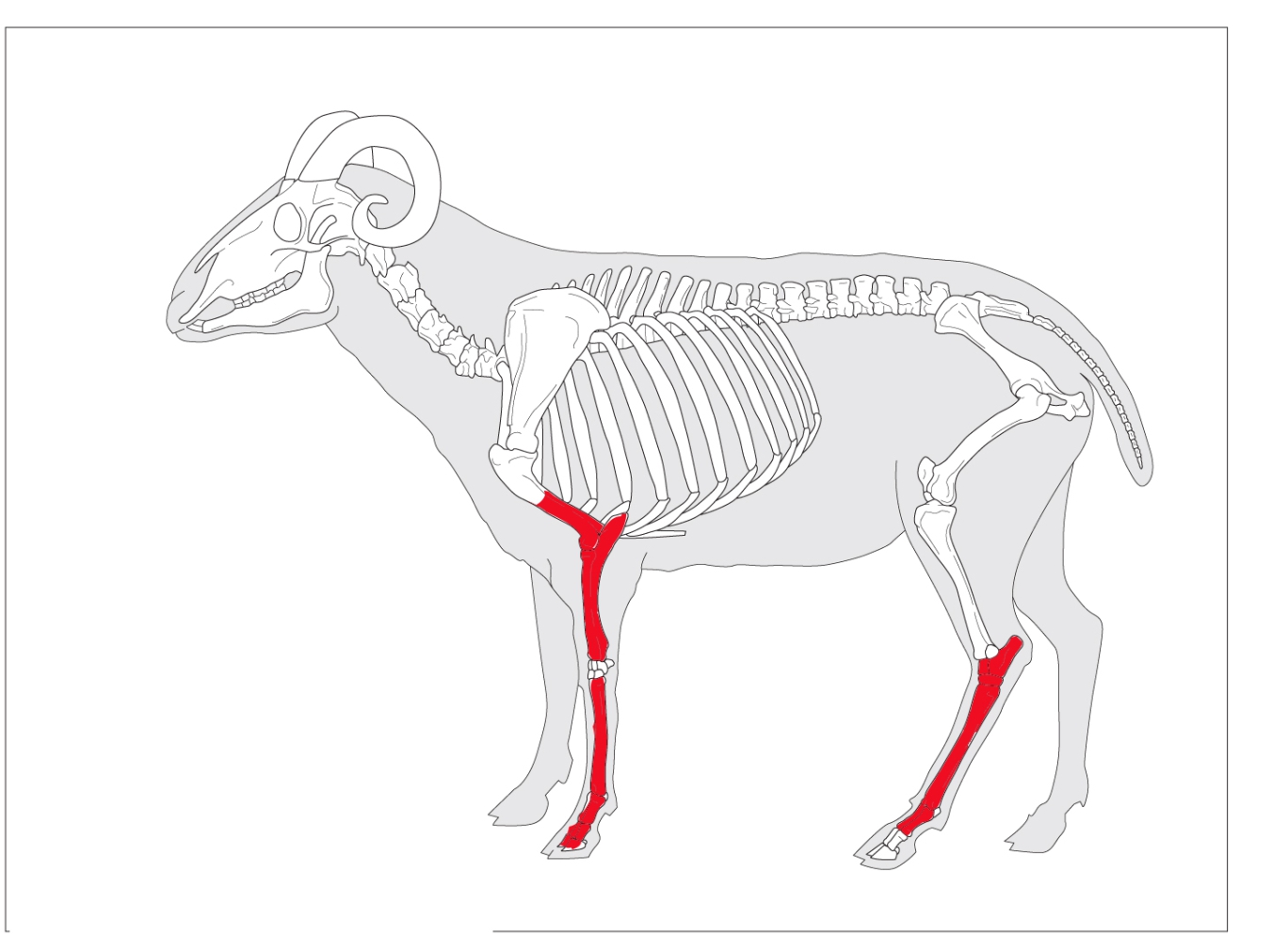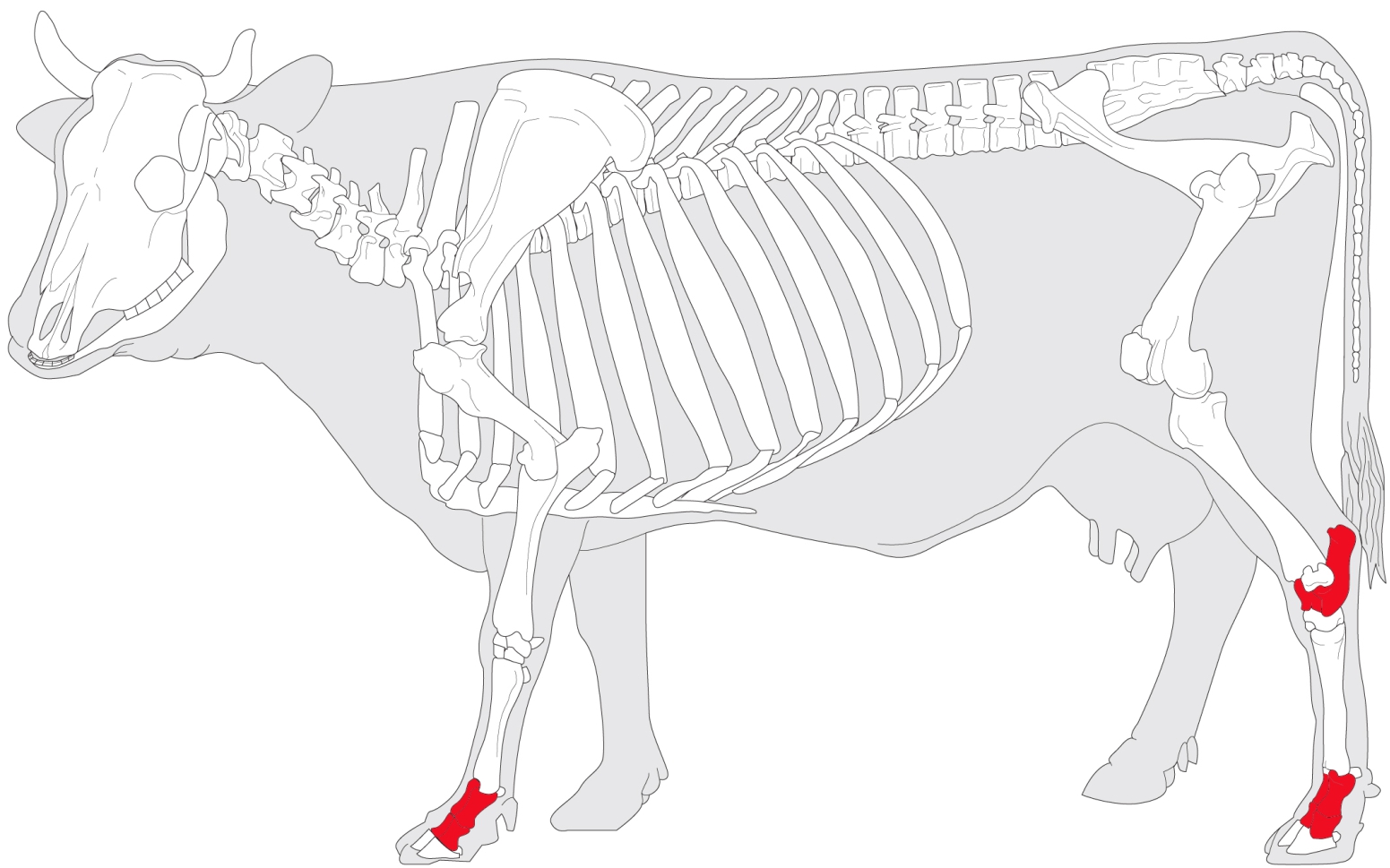Zooarchaeology
The zooarchaeological assemblage (terrestrial fauna) from Neolithic Avgi: Preliminary results (2012-2013)
Analysis of the faunal assemblage from Neolithic Avgi was carried out for a 3-month period during 2012-2013. Selection of contexts for detailed analysis was based on the available information from more advanced studies of other types of archaeological material (pottery, stone tools, archaeobotanical remains, etc.), also coupled with emerging discussions, thoughts and inquiries, regarding the use of open spaces during Avgi I and II, as well as of pits during Avgi III. Hence, analysis included bones from open areas allocated in the Western Sector, as well as from several pits, in order to investigate potential differences in bone consumption and deposition in various types of context.
During the preliminary sorting of the material, only specimens, which could be identified as to species and body part (using atlases and a modern reference collection) and would facilitate valid statistical analysis, were included. The anatomical units selected for further examination included mandibles, loose mandibular teeth, horn-cores/antlers, scapula (articular area and column), humerus, radius, ulna, metapodials, pelvis (parts near the acetabulum), femur, tibia, astragalus, calcaneum and phalanges. Selected elements were conserved (i.e. fresh breaks were mended, in order to avoid artificial inflation of counts) and marked with individual contextual information, in an attempt to enable identification of possible articulating and/or matching elements between different areas/contexts. Articulating and/or matching elements were sought in adjacent body parts (humerus-radius-ulna, distal tibia-astragalus-calcaneum, distal metapodials-phalanges). Finally, all specimens were recorded individually, reaching so far ca. 2000 MaxAU . The variables recorded include information about species, anatomical unit, side, age, preservation, fragmentation, pathology, butchery, sex and biometry. The methodology adopted was directly related with the questions posed and enabled the understanding of farming activities (animal management), as well as meat consumption and deposition.
The statistical analysis of the recorded assemblage, though still at a preliminary stage, has yielded several interesting results, especially when compared with the assemblage collected for the area east of Building 5. To begin with, species representation is compatible with other known late neolithic sites, including sheep, pigs, cattle, goats and dogs, presented in descending order. A few specimens of wild game (mainly deer, boar and hare) and carnivores (bear, fox, badger, etc.) have also been identified. Preservation of recorded elements seems to be compatible with suggested contextual differentiation, i.e. elements recovered from pits exhibit less gnawing and attrition, as opposed to elements deriving from open (thus more exposed to weathering) areas. Nonetheless, distribution of articulating and/or matching elements does not indicate similar contextual differences. Interestingly enough, so far, there does not seem to be a difference in the depositional patterns involved between different types of context, e.g. open spaces versus pits, since articulating/matching elements have been spotted in both cases. Albeit, this similarity might have resulted from the higher percentage of gnawing in open spaces, leading to fewer complete bone ends, thus suppressing an actually higher number of articulating and/or matching elements in this type of context.
Although detailed analysis of butchery marks remains to be completed, some preliminary observations can be made. Even allowing for misidentification of cut-marks due to carnivore attrition, the percentage of bones with cut-marks is relatively low (ca. 8-10%), suggesting preparation of meat using methods that would not require cutting up of the carcass, such as use of spits, rather than small-sized pots. In addition, the presence of a higher number of unusual articulating elements of pig, as opposed to sheep/goat, indicates different ways of cooking preparation between these species.
An evaluation of management strategies is dependent on cumulative death curves. Preliminary results indicate that sheep are mainly killed relatively young (around the first year of life), whereas the majority of sexed pelves belong to female animals. The implication is that sheep management is more compatible with a meat-oriented management regime, even though mixed (yet of low yield) strategies cannot be excluded. Unfortunately, mandibles of goat and cattle are extremely few for any safe assessments to be made at this point of the analysis. Female pigs are also most abundant, while the culling age of pigs (around the second half of first year/first year of life) suggests that, at least on some occasions, pig consumption was practiced beyond the household level, even allowing for the use of preservation methods (smoking, salt, etc.) for some meat parcels. Undoubtedly, this suggestion needs to be further explored, since other parameters, such as breeding circles and culling period, as indicated by age at death, must be also considered. Nonetheless, it seems highly likely that, given the hot greek summers, which would pose restrictions even in the preservation of cured meat, some of the animals could have been consumed by a number of people, exceeding that of a family.
Fig. 1: Articulating elements of sheep/goat.
Fig. 2: Articulating elements of pig.
Fig. 3: Articulating elements of cow.
Bibliography:
Binford, L. R. 1981. Bones: Ancient Men and Modern Myths. New York: Academic Press.
Boessneck, J. 1969. Osteological differences between sheep (Ovis aries Linné) and goats (Capra hircus Linné). In: Brothwell, D. and E. Higgs (eds.) 1969. Science in Archaeology. London: Thames and Hudson: 331-358.
Bull, G. and S. Payne 1982. Tooth eruption and epiphyseal fusion in pigs and wild boar. In: Wilson, B., C. Grigson and S. Payne (eds.) 1982. Ageing and Sexing Animal Bones from Archaeological Sites. BAR British Series 109. Oxford: British Archaeological Reports: 55-71.
Deniz, E. and S. Payne 1982. Eruption and wear in the mandibular dentition as a guide to ageing Turkish Angora goats. In: Wilson, B., C. Grigson and S. Payne (eds.) 1982. Ageing and Sexing Animal Bones from Archaeological Sites. BAR British Series 109. Oxford: British Archaeological Reports: 155-205.
Grant, A. 1982. The use of tooth wear as a guide to the age of domestic ungulates. In: Wilson, B., C. Grigson and S. Payne (eds.) 1982. Ageing and Sexing of Animals from Archaological Sites. Oxford: 91-108.
Greenfield, H. J. 2002. Distinguishing metal (steel and low-tin bronze) from stone (flint and obsidian) tool cut-marks on bone: an experimental approach. In: Mathieu, J. R. (ed.) 2002. Experimental Archaeology: Replicating Past Objects, Behaviours and Processes. BAR International Series 1035. Oxford: British Archaeological Reports:
Halstead, P., Collins, P. and V. Isaakidou 2002. Sorting the sheep from goats: morphological distintions between the mandibles and mandibular teeth of adult Ovis and Capra. Journal of Archaeological Science 29: 545-553.
Payne, S. 1985. Morphological distinctions between the mandibular teeth of young sheep, Ovis, and goats, Capra. Journal of Archaeological Science 12: 139-147.
Schmidt, E. 1972. Atlas of Animal Bones For Prehistorians, Archaeologists and Quaternary Geologists. Amsterdam-London-New York: Elsevier Publishing Company.
Stratouli, G., Bekiaris, T., Katsikaridis, N. and V. Tzevelekidi, in press. Integrating the past, determining the present, establishing the future: identification and interpretation of structured deposition at the neolithic settlement of Avgi in Kastoria, Northern Greece. Conference proceedings, 100 years of Prehistoric Research in Macedonia, Thessaloniki 21-24 December 2012.
Tzevelekidi, V. 2012. Dressing for Dinner. Bone Butchery and Deposition at Late Neolithic Toumba Kremastis-Koiladas, Northern Greece. BAR International Series 2541.
Tzevelekidi, V., Halstead, P. and V. Isaakidou, in press. Invitation to dinner: animal bone consumption and deposition at Makriyalos in Pieria and Toumba Kremastis-Koiladas in Kozani. Conference proceedings, 100 years of Prehistoric Research in Macedonia, Thessaloniki, 21-24 December 2012.
von den Driesch, A. 1976. A Guide to the Measurement of Animal Bones from Archaeological Sites. Peabody Museum Bulletin 1. Cambridge: Harvard University.
November 2013
Dr. Vasiliki Tzevelekidi vasiliki.tzevelekidi@gmail.com
Previous document:
Analysis of the faunal assemblage from the neolithic settlement at Avgi (Kastoria)
Excavations at the neolithic site of Avgi have already uncovered a large assemblage of animal bones. Preliminary observations have revealed that the vast majority of this assemblage consists of domesticated animals (sheep, goats, pigs and cattle -in approximately descending order), while only a small percentage of wild game has also been identified (wild boar, deer, foxes). Recovery of the assemblage is being carried out systematically and follows the stratigraphic sequence, as it can be understood through a) observation in the field, and b) the study of other (more informative in terms of chronology) categories of archaeological material.
.png) Analysis of the faunal material from Avgi is very important, as it derives from a flat extended neolithic site, which, unlike complex stratigraphic sequences in neolithic magoules, offers good contextual control, allowing investigation at the level of smaller contexts rather that of the settlement, enabling the investigation of differences/similarities within the neolithic society. Additionally, the identification of pits, containing a wide variety of archaeological material (pottery, bone/stone tools, bioarchaeological material) allows the investigation of different depositional environments, which are thought to reflect ‘special’ activities/behaviors. Finally, the size and state of preservation of the assemblage is ideal for understanding the economic strategies followed by neolithic farmers.
Analysis of the faunal material from Avgi is very important, as it derives from a flat extended neolithic site, which, unlike complex stratigraphic sequences in neolithic magoules, offers good contextual control, allowing investigation at the level of smaller contexts rather that of the settlement, enabling the investigation of differences/similarities within the neolithic society. Additionally, the identification of pits, containing a wide variety of archaeological material (pottery, bone/stone tools, bioarchaeological material) allows the investigation of different depositional environments, which are thought to reflect ‘special’ activities/behaviors. Finally, the size and state of preservation of the assemblage is ideal for understanding the economic strategies followed by neolithic farmers.
 The analysis of the faunal material includes a) the preliminary sorting of the assemblage, so that the specimens that will be included in the analysis are separated (bones that can be identified with certainty to the level of species and body part and can be used for statistical analysis), b) conservation of the selected specimens, c) marking of the contextual information on every specimen, and d) recording of information regarding species, body part, age, preservation, fragmentation, butchery and biometry. Recording of the above data will enable the understanding of farming activities (animal management), as well as meat consumption (at smaller/larger scale), which has been proposed as playing a basic role during ‘special’ communal activities during the Neolithic.
The analysis of the faunal material includes a) the preliminary sorting of the assemblage, so that the specimens that will be included in the analysis are separated (bones that can be identified with certainty to the level of species and body part and can be used for statistical analysis), b) conservation of the selected specimens, c) marking of the contextual information on every specimen, and d) recording of information regarding species, body part, age, preservation, fragmentation, butchery and biometry. Recording of the above data will enable the understanding of farming activities (animal management), as well as meat consumption (at smaller/larger scale), which has been proposed as playing a basic role during ‘special’ communal activities during the Neolithic.
1. www.archaeologyexpert.co.uk/AnimalBones.html
Vasiliki Tzevelekidi
The University of Sheffield,
Department of Archaeology and Prehistory,
Northgate House,
West Street,
S1 4ET Sheffield,
UK
v.tzevelekidi@shef.ac.uk
vasiliki.tzevelekidi@gmail.com




